Interface Dynamics and the Influence of Gravity on Droplet Generation in a Y-microchannel
Abstract
1. Introduction
2. Materials and Methods
2.1. Microgeometry—Design and Technological Aspects
2.2. Fluid Samples
2.3. Experimental Setup and Visualizations
3. Results and Analysis
3.1. The Influence of Gravity on Droplet Length
- Gravity has a relevant influence on dependence, the length increasing with ; the slope against was almost zero for the vertical position, the highest value being observed in case (ii), shown in Figure 8, i.e., a less dense liquid at the bottom;
- At , the influence of gravity was absent; the orientation of the channel did not influence
3.2. Interface Breakup Dynamics and Droplet Formation
- R1. Sharp decrease in the slip velocity and increase in the contact angle;
- R2. Constant slip velocity and contact angle (domain where the slip velocity is proportional to the product between the capillary velocity and ) [43];
- R3. Slide increase in contact angle and small oscillations in slip velocity. At the end of the R3 regime, the droplet interface reaches the steady state, i.e., the plug flow.
4. Conclusions
Supplementary Materials
Author Contributions
Funding
Data Availability Statement
Acknowledgments
Conflicts of Interest
References
- Golay, M.J.E. Vapor Phase Chromatography and Telegrapher’s Equation. Anal. Chem. 1957, 29, 928–932. [Google Scholar] [CrossRef]
- Karniadakis, G.; Beskok, A.; Aluru, N. Microflows and Nanoflows|Fundamentals and Simulation, 1st ed.; Springer: New York, NY, USA, 2005. [Google Scholar] [CrossRef]
- Bruus, H. Theoretical Microfluidics, 1st ed.; Oxford University Press: New York, NY, USA, 2007. [Google Scholar]
- Abgrall, P.; Gué, A.-M. Lab-on-Chip Technologies: Making a Microfluidic Network and Coupling It into a Complete Microsystem—A Review. J. Micromech. Microeng. 2007, 17, R15–R49. [Google Scholar] [CrossRef]
- Lei, L.; Zhao, Y.; Chen, W.; Li, H.; Wang, X.; Zhang, J. Experimental Studies of Droplet Formation Process and Length for Liquid—Liquid Two-Phase Flows in a Microchannel. Energies 2021, 14, 1341. [Google Scholar] [CrossRef]
- van der Graaf, S.; Steegmans, M.L.J.; van der Sman, R.G.M.; Schroën, C.G.P.H.; Boom, R.M. Droplet Formation in a T-Shaped Microchannel Junction: A Model System for Membrane Emulsification. Colloids Surf. A Physicochem. Eng. Asp. 2005, 266, 106–116. [Google Scholar] [CrossRef]
- Sang, L.; Hong, Y.; Wang, F. Investigation of Viscosity Effect on Droplet Formation in T-Shaped Microchannels by Numerical and Analytical Methods. Microfluid. Nanofluid. 2009, 6, 621–635. [Google Scholar] [CrossRef]
- Kovalev, A.V.; Yagodnitsyna, A.A.; Bilsky, A.V. Viscosity Ratio Influence on Liquid-Liquid Flow in a T-Shaped Microchannel. Chem. Eng. Technol. 2021, 44, 365–370. [Google Scholar] [CrossRef]
- Damian, I.R.; Hardt, S.; Balan, C. From Flow Focusing to Vortex Formation in Crossing Microchannels. Microfluid. Nanofluid. 2017, 21, 142. [Google Scholar] [CrossRef]
- Wu, Z.; Cao, Z.; Sunden, B. Flow Patterns and Slug Scaling of Liquid-Liquid Flow in Square Microchannels. Int. J. Multiph. Flow 2019, 112, 27–39. [Google Scholar] [CrossRef]
- Derzsi, L.; Kasprzyk, M.; Plog, J.P.; Garstecki, P. Flow Focusing with Viscoelastic Liquids. Phys. Fluids 2013, 25, 92001. [Google Scholar] [CrossRef]
- He, P.; Barthès-Biesel, D.; Leclerc, E. Flow of Two Immiscible Liquids with Low Viscosity in y Shaped Microfluidic Systems: Effect of Geometry. Microfluid. Nanofluid. 2010, 9, 293–301. [Google Scholar] [CrossRef]
- Bălan, C.M.; Broboană, D.; Bălan, C. Investigations of Vortex Formation in Microbifurcations. Microfluid. Nanofluid. 2012, 13, 819–833. [Google Scholar] [CrossRef]
- Nasir, M.; Mott, D.R.; Kennedy, M.J.; Golden, J.P.; Ligler, F.S. Parameters Affecting the Shape of a Hydrodynamically Focused Stream. Microfluid. Nanofluid. 2011, 11, 119–128. [Google Scholar] [CrossRef]
- Kang, D.-K.; Monsur Ali, M.; Zhang, K.; Pone, E.J.; Zhao, W. Droplet Microfluidics for Single-Molecule and Single-Cell Analysis in Cancer Research, Diagnosis and Therapy. TrAC Trends Anal. Chem. 2014, 58, 145–153. [Google Scholar] [CrossRef]
- Caviglia, G.P.; Abate, M.L.; Tandoi, F.; Ciancio, A.; Amoroso, A.; Salizzoni, M.; Saracco, G.M.; Rizzetto, M.; Romagnoli, R.; Smedile, A. Quantitation of HBV CccDNA in Anti-HBc-Positive Liver Donors by Droplet Digital PCR: A New Tool to Detect Occult Infection. J. Hepatol. 2018, 69, 301–307. [Google Scholar] [CrossRef]
- Segaliny, A.I.; Li, G.; Kong, L.; Ren, C.; Chen, X.; Wang, J.K.; Baltimore, D.; Wu, G.; Zhao, W. Functional TCR T Cell Screening Using Single-Cell Droplet Microfluidics. Lab Chip 2018, 18, 3733–3749. [Google Scholar] [CrossRef] [PubMed]
- Shao, C.; Chi, J.; Zhang, H.; Fan, Q.; Zhao, Y.; Ye, F. Development of Cell Spheroids by Advanced Technologies. Adv. Mater. Technol. 2020, 5, 2000183. [Google Scholar] [CrossRef]
- Liu, Y.; Yang, M.; Jiang, T.; Lan, C.; Yuan, H.; Li, G.; Jia, G.; Wang, K.; Zhao, G. Quantitative Analysis of HER2 Amplification by Droplet Digital PCR in the Follow-Up of Gastric Cancer Patients Being Treated with Trastuzumab after Surgery. Gastroenterol. Res. Pract. 2019, 2019, 1750329. [Google Scholar] [CrossRef]
- Sarkar, S.; Cohen, N.; Sabhachandani, P.; Konry, T. Phenotypic Drug Profiling in Droplet Microfluidics for Better Targeting of Drug-Resistant Tumors. Lab Chip 2015, 15, 4441–4450. [Google Scholar] [CrossRef]
- Nightingale, A.M.; Leong, C.L.; Burnish, R.A.; Hassan, S.; Zhang, Y.; Clough, G.F.; Boutelle, M.G.; Voegeli, D.; Niu, X. Monitoring Biomolecule Concentrations in Tissue Using a Wearable Droplet Microfluidic-Based Sensor. Nat. Commun. 2019, 10, 2741. [Google Scholar] [CrossRef]
- Srinivasan, V.; Pamula, V.K.; Fair, R.B. Droplet-Based Microfluidic Lab-on-a-Chip for Glucose Detection. Anal. Chim. Acta 2004, 507, 145–150. [Google Scholar] [CrossRef]
- Piao, Y.; Han, D.J.; Azad, M.R.; Park, M.; Seo, T.S. Enzyme Incorporated Microfluidic Device for In-Situ Glucose Detection in Water-in-Air Microdroplets. Biosens. Bioelectron. 2015, 65, 220–225. [Google Scholar] [CrossRef] [PubMed]
- Luk, V.N.; Wheeler, A.R. A Digital Microfluidic Approach to Proteomic Sample Processing. Anal. Chem. 2009, 81, 4524–4530. [Google Scholar] [CrossRef] [PubMed]
- Wheeler, A.R.; Moon, H.; Bird, C.A.; Ogorzalek Loo, R.R.; Kim, C.-J."C.J."; Loo, J.A.; Garrell, R.L. Digital Microfluidics with In-Line Sample Purification for Proteomics Analyses with MALDI-MS. Anal. Chem. 2005, 77, 534–540. [Google Scholar] [CrossRef]
- Clausell-Tormos, J.; Lieber, D.; Baret, J.-C.; El-Harrak, A.; Miller, O.J.; Frenz, L.; Blouwolff, J.; Humphry, K.J.; Köster, S.; Duan, H.; et al. Droplet-Based Microfluidic Platforms for the Encapsulation and Screening of Mammalian Cells and Multicellular Organisms. Chem. Biol. 2008, 15, 427–437. [Google Scholar] [CrossRef] [PubMed]
- Eggers, J.; Villermaux, E. Physics of Liquid Jets. Rep. Prog. Phys. 2008, 71, 36601. [Google Scholar] [CrossRef]
- Guan, T.; Gao, Y.; Pan, M.; Wu, Y.; Zhang, S.; Xu, L.; Zhu, L.; Yun, J. Slug Flow Hydrodynamics of Immiscible Fluids within a Rectangular Microchannel towards Size-Controllable Fabrication of Dextran-Based Cryogel Beads. Chem. Eng. J. 2019, 369, 116–123. [Google Scholar] [CrossRef]
- Nunes, J.K.; Tsai, S.S.H.; Wan, J.; Stone, H.A. Dripping and Jetting in Microfluidic Multiphase Flows Applied to Particle and Fibre Synthesis. J. Phys. D. Appl. Phys. 2013, 46, 114002. [Google Scholar] [CrossRef]
- Giorello, A.; Minetti, F.; Nicastro, A.; Berli, C.L.A. The Effect of Gravity on Microfluidic Flow Focusing. Sens. Actuators B Chem. 2020, 307, 127595. [Google Scholar] [CrossRef]
- Norouzi, N.; Bhakta, H.; Grover, W. Orientation-Based Control of Microfluidics. PLoS ONE 2016, 11, e0149259. [Google Scholar] [CrossRef]
- Koshy, A.; Ray, S.; Das, G. Between Droplets and Fluid Thread—The Role of Gravity in Meso-Scale Flow. Phys. Fluids 2021, 33, 73309. [Google Scholar] [CrossRef]
- Kim, S.-H.; Lee, S.; Ahn, D.; Park, J.Y. PDMS Double Casting Method Enabled by Plasma Treatment and Alcohol Passivation. Sens. Actuators B Chem. 2019, 293, 115–121. [Google Scholar] [CrossRef]
- Onclin, S.; Ravoo, B.J.; Reinhoudt, D.N. Engineering Silicon Oxide Surfaces Using Self-Assembled Monolayers. Angew. Chem. Int. Ed. 2005, 44, 6282–6304. [Google Scholar] [CrossRef] [PubMed]
- Gitlin, L.; Schulze, P.; Belder, D. Rapid Replication of Master Structures by Double Casting with PDMS. Lab Chip 2009, 9, 3000–3002. [Google Scholar] [CrossRef] [PubMed]
- Owen, M.J.; Smith, P.J. Plasma Treatment of Polydimethylsiloxane. J. Adhes. Sci. Technol. 1994, 8, 1063–1075. [Google Scholar] [CrossRef]
- Chiriac, E.; Avram, M.; Balan, C. Investigation of Multiphase Flow in a Trifurcation Microchannel—A Benchmark Problem. Micromachine 2022, 13, 974. [Google Scholar] [CrossRef]
- Foroozan Jahromi, P.; Karimi-Sabet, J.; Amini, Y.; Fadaei, H. Pressure-Driven Liquid-Liquid Separation in Y-Shaped Microfluidic Junctions. Chem. Eng. J. 2017, 328, 1075–1086. [Google Scholar] [CrossRef]
- Mbanjwa, M.B.; Harding, K.; Gledhill, I.M.A. Numerical Modelling of Mixing in a Microfluidic Droplet Using a Two-Phase Moving Frame of Reference Approach. Micromachines 2022, 13, 708. [Google Scholar] [CrossRef]
- Venkateshwarlu, A.; Bharti, R.P. Effects of Capillary Number and Flow Rates on the Hydrodynamics of Droplet Generation in Two-Phase Cross-Flow Microfluidic Systems. J. Taiwan Inst. Chem. Eng. 2021, 129, 64–79. [Google Scholar] [CrossRef]
- Liang, D.; Ma, P.; Zhu, C.; Fu, T.; Ma, Y.; Wang, K.; Luo, G. Manipulable Formation of Ferrofluid Droplets in Y-Shaped Flow-Focusing Microchannels. Ind. Eng. Chem. Res. 2019, 58, 19226–19238. [Google Scholar] [CrossRef]
- Broboana, D.; Bratu, A.-M.; Magos, I.; Patrascu, C.; Balan, C. Kinematics of the Viscous Filament during the Droplet Breakup in Air. Sci. Rep. 2022, 12, 1774. [Google Scholar] [CrossRef]
- Drazin, P.G.; Reid, W.H. Hydrodynamic Stability; Cambridge University Press: Cambridge, UK, 1981. [Google Scholar]
- Sarrazin, F.; Loubière, K.; Prat, L.; Gourdon, C.; Bonometti, T.; Magnaudet, J. Experimental and Numerical Study of Droplets Hydrodynamics in Microchannels. AIChE J. 2006, 52, 4061–4070. [Google Scholar] [CrossRef]

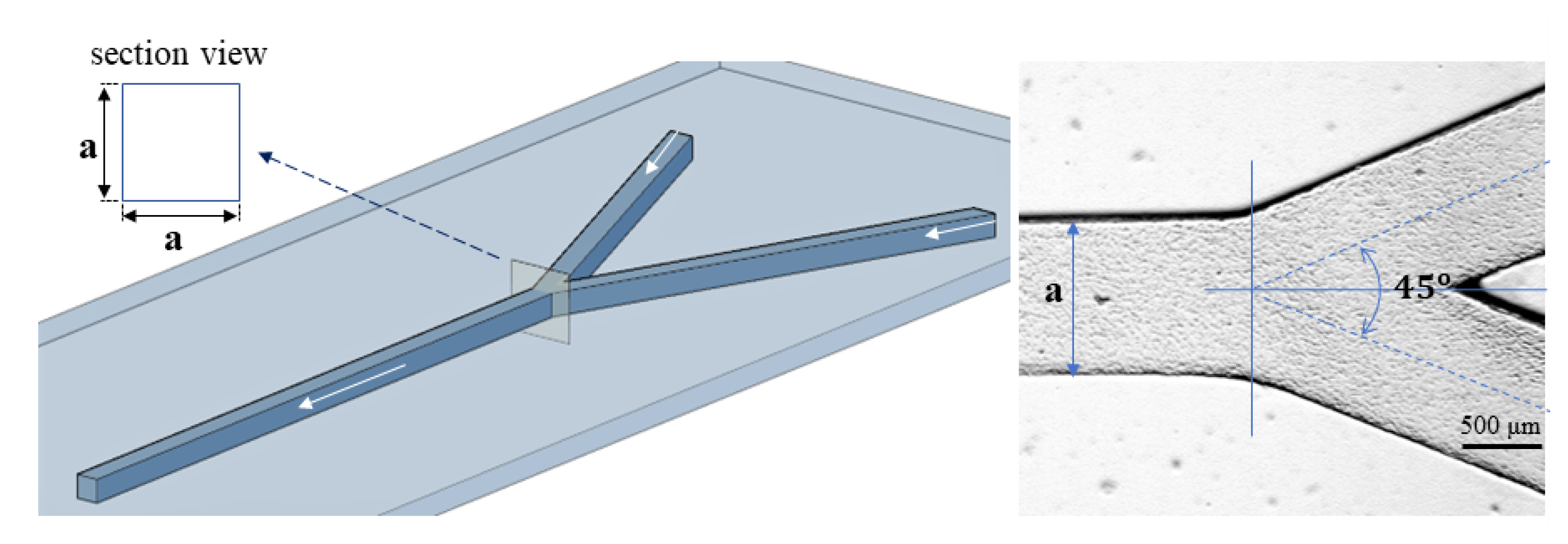
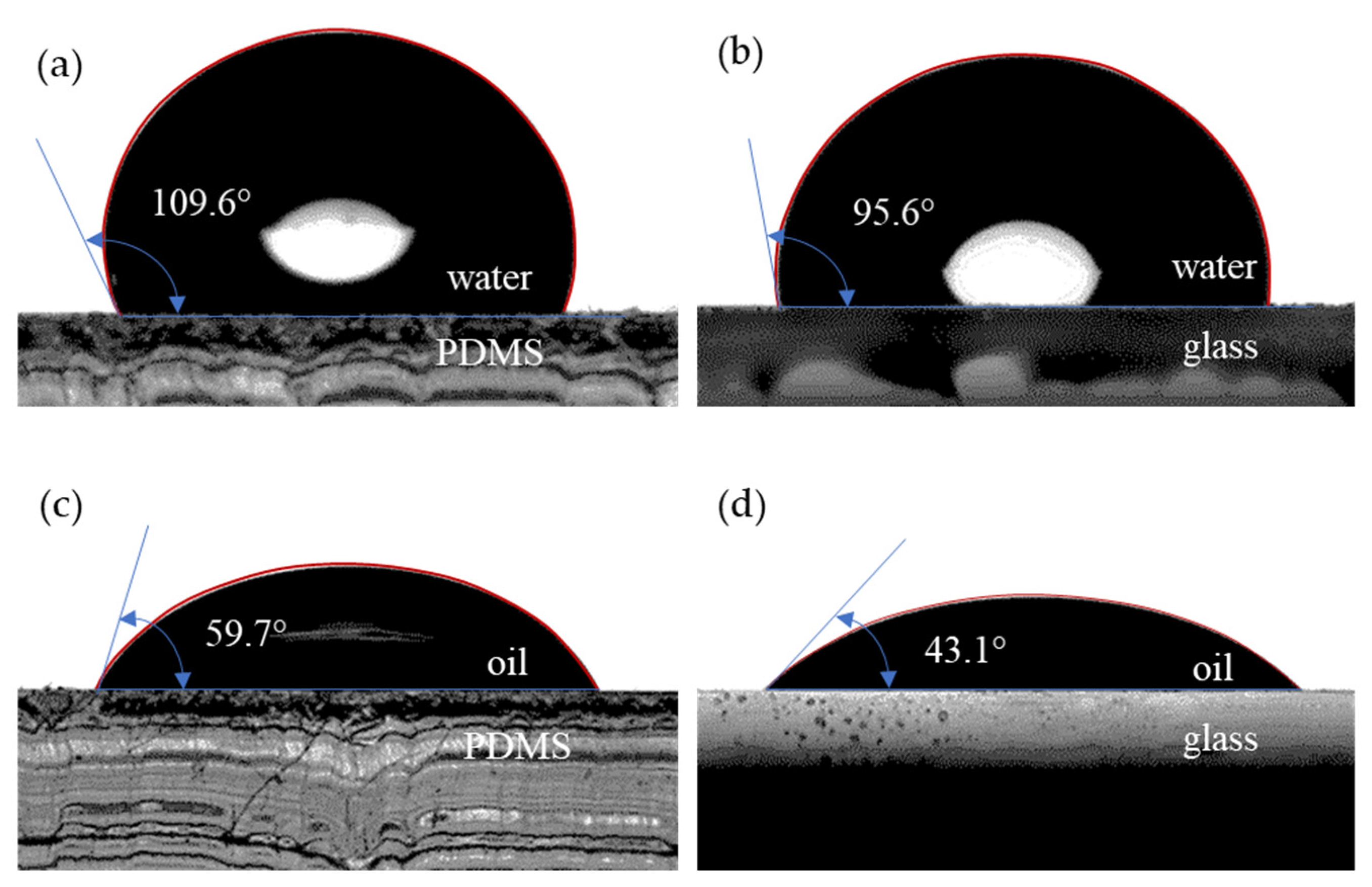

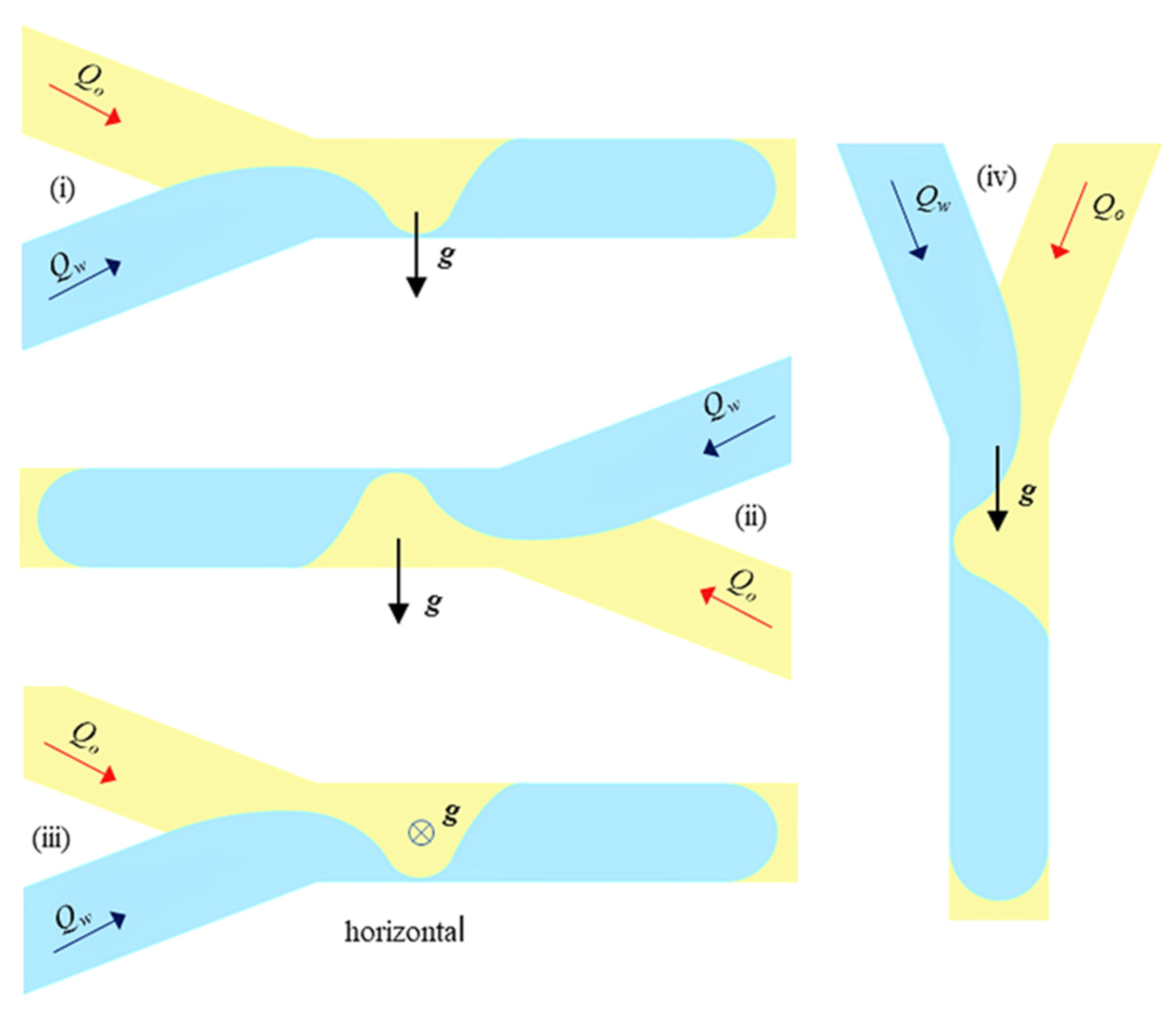
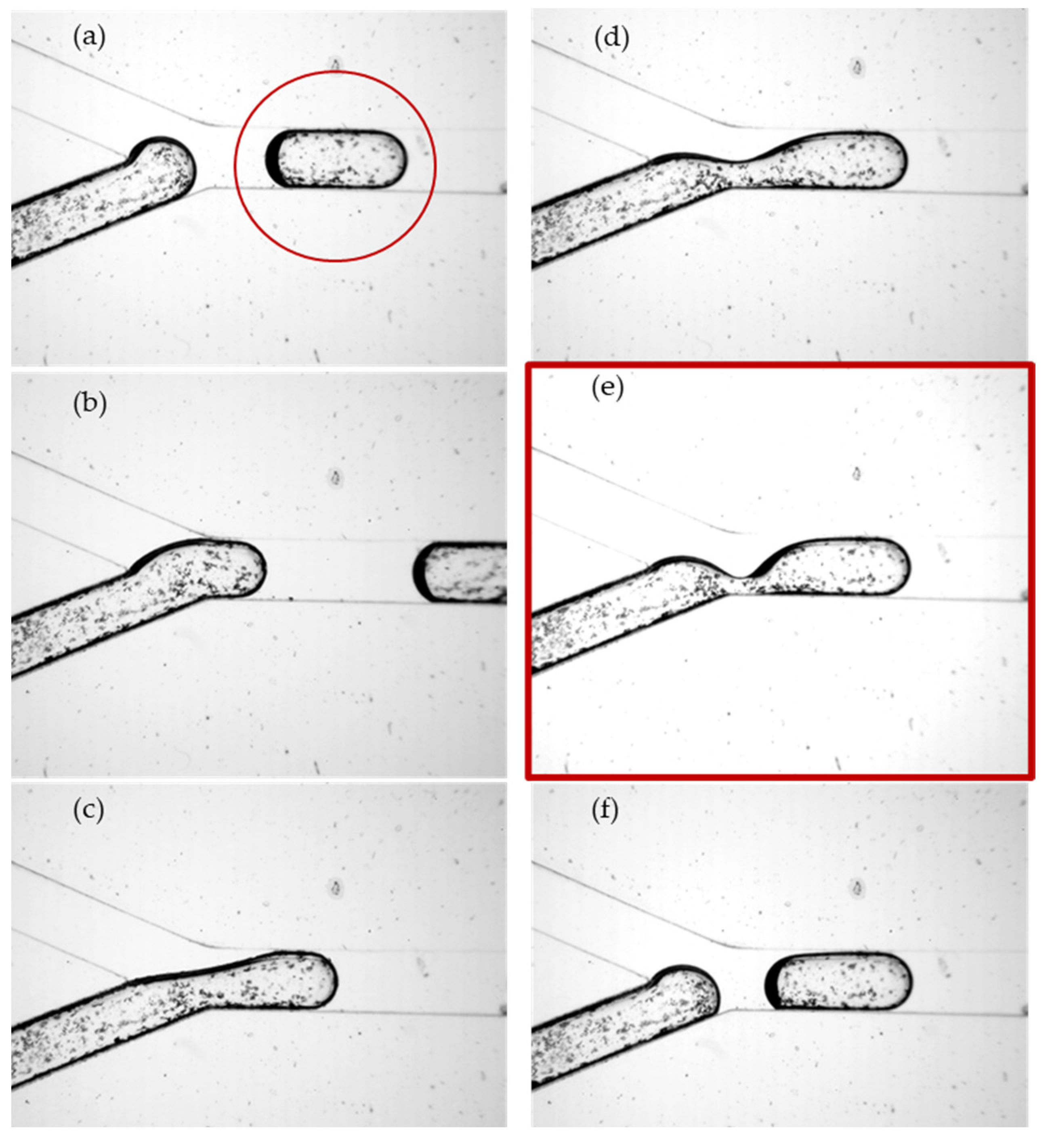
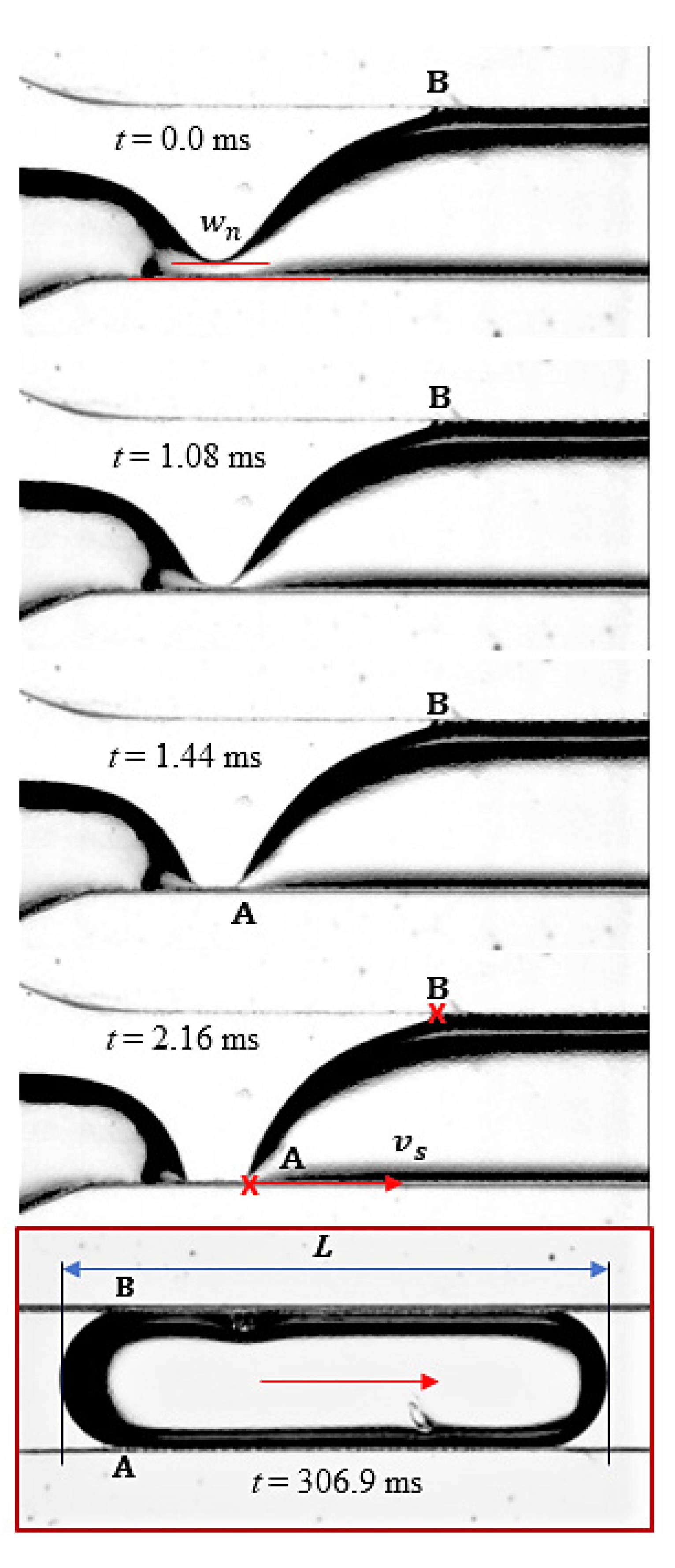
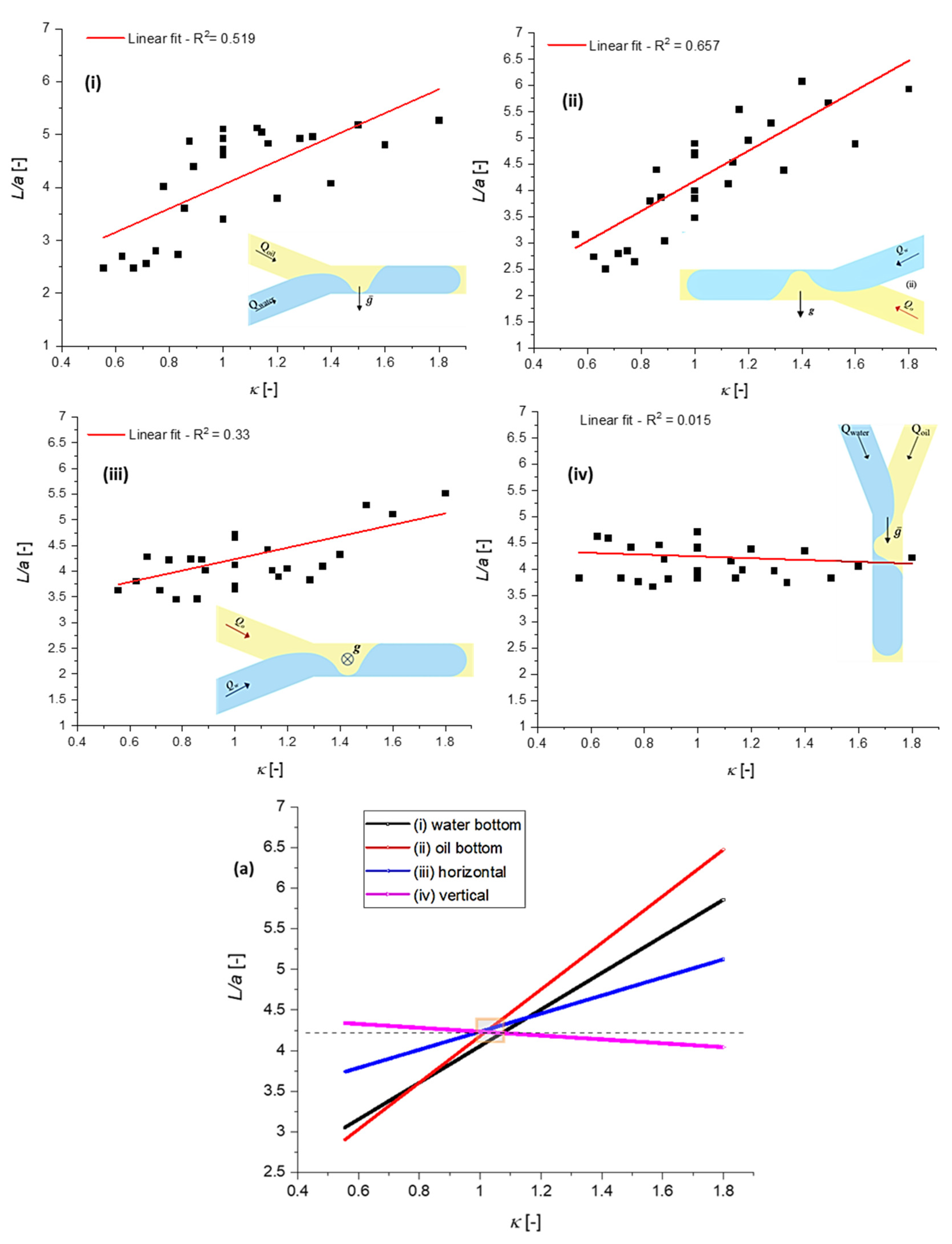
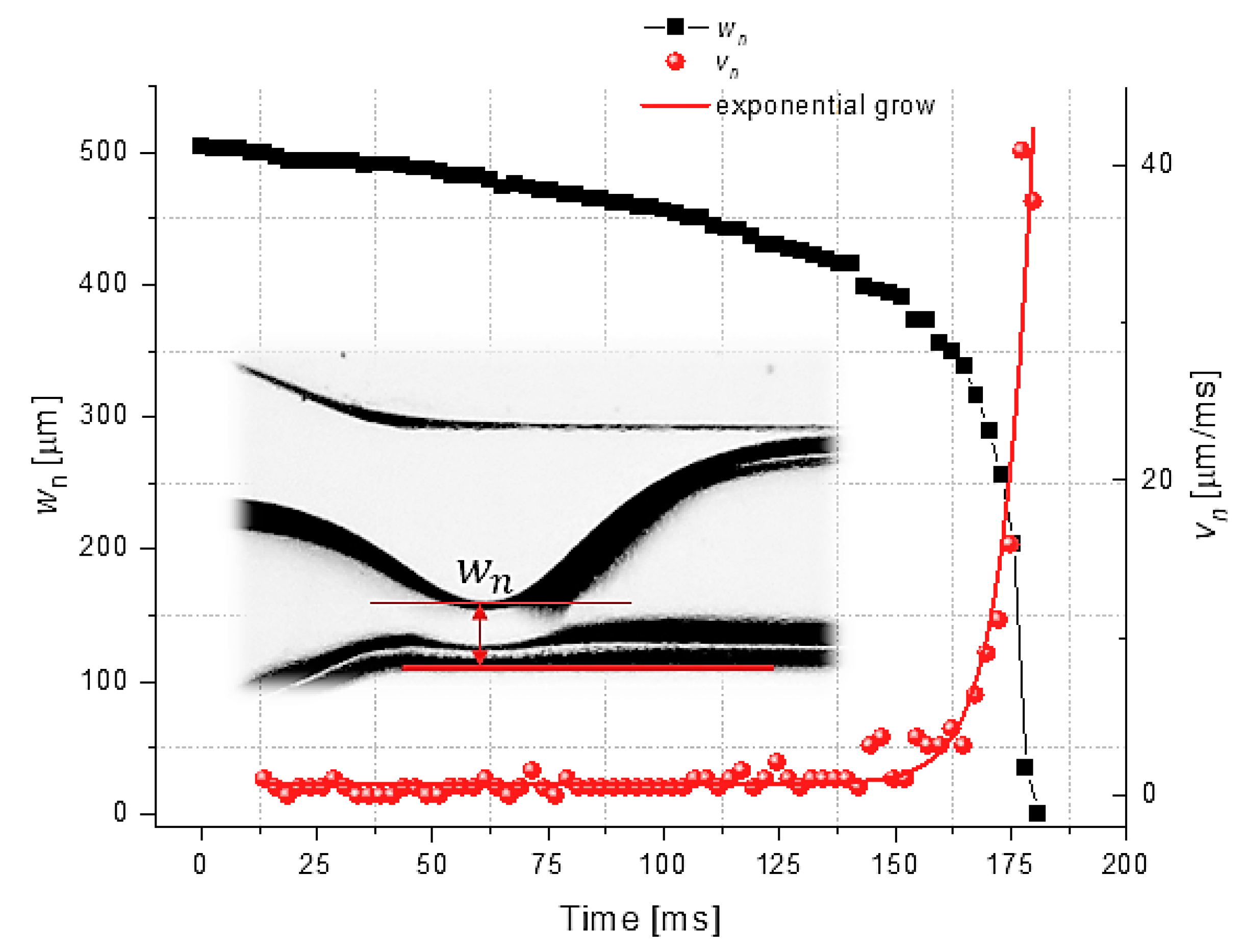

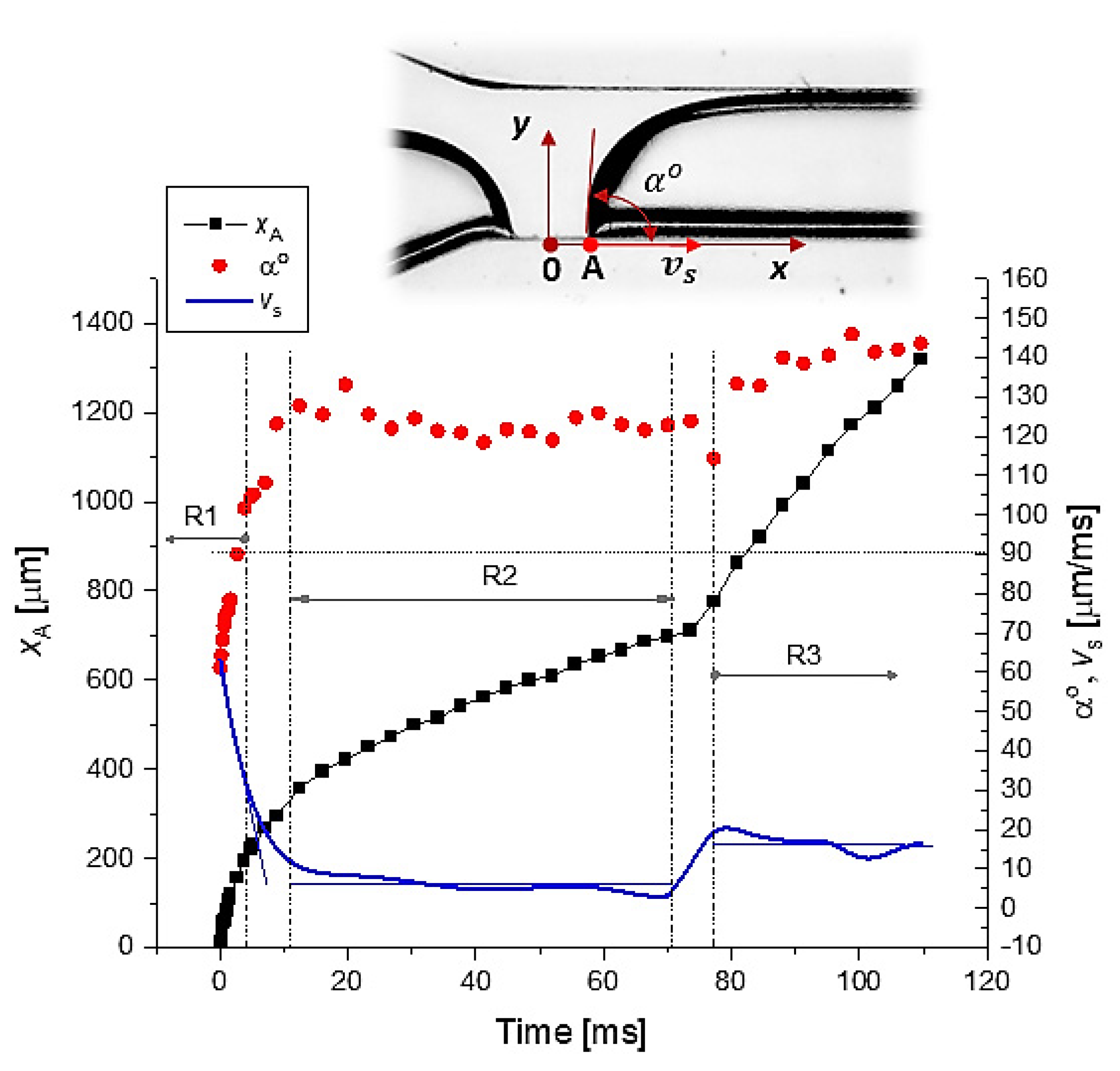
| Fluid | |||
|---|---|---|---|
| Deionized water Sunflower oil | 1000 925 | 1 55 | 0.025 |
| Symbol/ Name | Relation | Values | Observations |
|---|---|---|---|
| We—Weber | Surface tension dominant against inertia | ||
| Oh—Ohnesorge | 0.345 | Friction in relative equilibrium with interfacial forces, 0.1 < Oh < 1 | |
| Bo—Bond | 0.035 | Surface tension dominant against gravity | |
| Ca—Capillary | Dripping regime with elongated droplets Ca < 0.005 | ||
| Re—Reynolds | Stokes flow regime |
Publisher’s Note: MDPI stays neutral with regard to jurisdictional claims in published maps and institutional affiliations. |
© 2022 by the authors. Licensee MDPI, Basel, Switzerland. This article is an open access article distributed under the terms and conditions of the Creative Commons Attribution (CC BY) license (https://creativecommons.org/licenses/by/4.0/).
Share and Cite
Bran, A.; Tanase, N.O.; Balan, C. Interface Dynamics and the Influence of Gravity on Droplet Generation in a Y-microchannel. Micromachines 2022, 13, 1941. https://doi.org/10.3390/mi13111941
Bran A, Tanase NO, Balan C. Interface Dynamics and the Influence of Gravity on Droplet Generation in a Y-microchannel. Micromachines. 2022; 13(11):1941. https://doi.org/10.3390/mi13111941
Chicago/Turabian StyleBran, Alexandra, Nicoleta Octavia Tanase, and Corneliu Balan. 2022. "Interface Dynamics and the Influence of Gravity on Droplet Generation in a Y-microchannel" Micromachines 13, no. 11: 1941. https://doi.org/10.3390/mi13111941
APA StyleBran, A., Tanase, N. O., & Balan, C. (2022). Interface Dynamics and the Influence of Gravity on Droplet Generation in a Y-microchannel. Micromachines, 13(11), 1941. https://doi.org/10.3390/mi13111941






